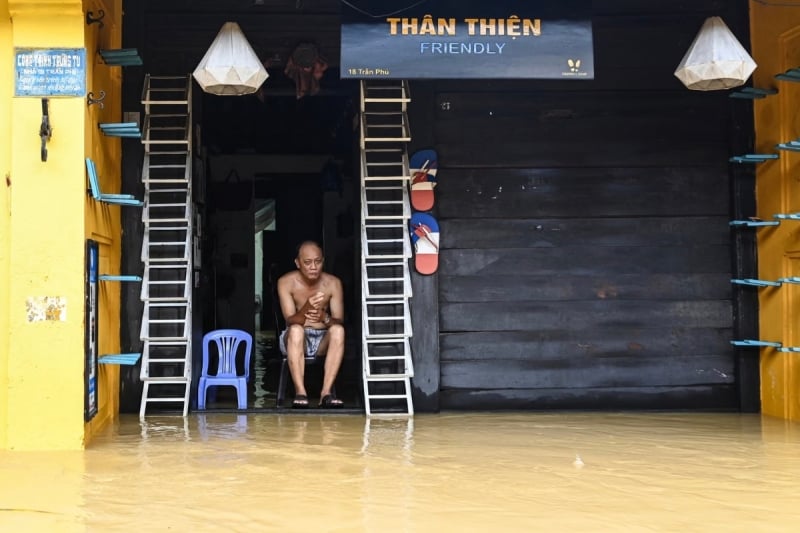Central Vietnam is facing one of its most severe weather disasters in recent years, with at least 41 people killed and nine still missing as of 21 November, after days of torrential rain, according to state media and provincial authorities. The flooding, which began over the weekend, has shown little sign of easing as more rain is forecast through Sunday.
Homes Submerged and Power Cut Across the Region

Image credit: AFP
More than 52,000 homes have been inundated, and over 500,000 households have been left without electricity. Entire neighbourhoods have been swallowed by floodwaters, forcing tens of thousands of residents to evacuate.
Tourist hotspots Hoi An and Nha Trang are among the hardest hit. In Nha Trang, residents waded through waist-deep water as streets turned into rivers. In Hoi An’s UNESCO-listed old town, muddy water seeped into shophouses and cafés, disrupting daily life and tourism ahead of the year-end travel season.
Further inland, districts in Gia Lai and Đắk Lắk saw rapid flash floods that required boats and emergency personnel to reach stranded families.
Landslides sever major highways

Image credit: AFP
The continuous downpour has triggered dangerous landslides throughout the Central Highlands. A large section of the Mimosa Pass, an important access route into the popular hill city of Da Lat, collapsed into a ravine, halting all traffic. A bus narrowly avoided plunging into the gap.
Authorities in Khanh Hoa, Gia Lai, and Đắk Lắk have since declared states of emergency as major highways, village roads, and mountain passes have become impassable.
Coffee harvest hit hard

Image credit: Hello5coffee official website
Central Vietnam, especially Đắk Lắk, the heart of the country’s coffee belt, is facing one of its most challenging harvest seasons in years. Flooding across the region has brought the coffee harvest to a near standstill, raising concerns for both local livelihoods and the global supply chain.
According to traders, only 10–15% of the crop has been harvested so far, a shockingly low figure for this stage of the season. Persistent rainfall and lack of sunlight are preventing beans from drying properly, which is a critical step that determines both quality and exportability. Wet beans are prone to mould, spoilage, and discoloration, meaning many farmers risk losing entire batches even if they manage to harvest them.
This means immediate financial losses for growers who depend on coffee as their primary income, and longer-term threats to the region’s output if damage delays future seasons. For Vietnam, the world’s second-largest coffee producer and the top supplier of robusta beans, this disruption could have ripple effects far beyond its borders, from rising global coffee prices to reduced supply for major exporters and roasters.
Severe blow to tourism and the local economy

Image credit: Nhac Nguyen via Getty Images
The floods have dealt a major setback to tourism, a vital pillar of Central Vietnam’s economy. In Hoi An, shop owners and restaurateurs are clearing thick mud from their lantern-filled streets, hoping to reopen soon even as uncertainty lingers over how quickly visitors will return.
Hotel cancellations have surged in both Hoi An and Nha Trang, and key roads remain impassable, discouraging travel during what should be the peak holiday season. Tourism operators warn that even a short disruption can have long-term effects because December usually brings a strong wave of domestic and international arrivals.
Local media reports add that small business owners in Hoi An have suffered losses reaching hundreds of millions of dong. With foot traffic gone, supporting sectors such as handicrafts, transport, and food suppliers are also feeling the strain, putting wider economic recovery at risk.
Travel Advisory for Visitors

Image credit: Nhac Nguyen via Getty Images
Travellers currently planning trips to central Vietnam are advised to postpone non-essential travel to affected provinces, as road closures, landslides, disrupted transport links, and power outages continue to create significant safety risks. Visitors should follow local advisories, stay in contact with accommodation providers for updates, avoid coastal and mountainous areas where conditions may deteriorate quickly, and anticipate temporary closures at attractions in Da Lat, Nha Trang, and Hoi An while clean-up and recovery efforts remain underway.
Looking ahead

Image credit: Nhac Nguyen via Getty Images
As central Vietnam braces for more rain, authorities continue to prioritise rescue operations and the restoration of essential services. For now, the focus remains on stabilising hard-hit communities and reopening critical transport links. With extreme weather events becoming more frequent across the region, travellers are encouraged to stay informed, plan flexibly, and remain mindful of evolving conditions, especially during the year-end monsoon period.




